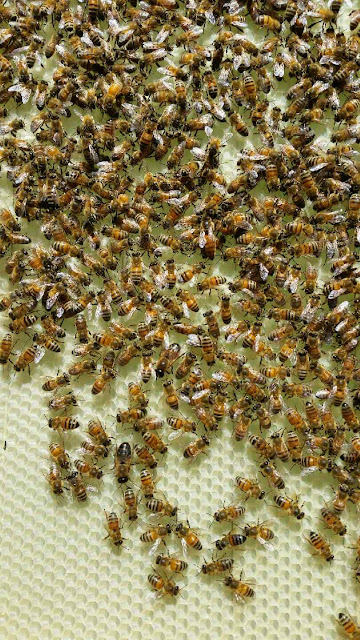Brian always turned the handle while I tipped in the milk to separate the cream from the milk in our antique cream separator. Now that I'm working only two days each week since I turned sixty in October, I'm trying to take on more of the jobs around here. So I taught myself to assemble all thirty of the pieces and now I can do the whole job myself.
It's an empowering feeling to learn more things isn't it?
A good workout turning that handle, then to turn the little tap just right so I can block the milk running through and quickly change buckets and tip in more milk. The first couple of times would have been pretty funny to watch, but now I feel more confident and the extra effort is well worth it.
The skim milk is the by-product which gets tipped into the two yogurt buckets sitting in the sun that is fed to the pigs and chooks after it turns into yogurt.
The cream... sigh... is swooningly good to eat and after a day in the fridge it is so thick the spoon stands up in the container.
It's the cleaning of all the pieces in hot soapy water that takes more time than the actual separating. Then all of the pieces must be placed to dry in the sun, or on the side of the stove, before packing it away ready for next time.
We inherited our separator from my older brother who found it when packing up his property for sale twelve years ago. We had just bought this property of ours and although cow ownership was the furthest thing in our minds back then, I'm so happy that we accepted this gift graciously.
Recently, the poor old thing has been making some disturbing noises, so I made inquiries about purchasing an electric separator and soon realised just how difficult they are to find in Australia.
Then Brian, Mr Handyman Extraordinaire, pulled apart the machine part of it, gave it a "service and oil" and joy of joys, it goes brilliantly once more. Ready for another fifty years of service.
My neighbor Meg shares my passion for
cheese making and recently, in return for some raw milk she gave me one of her
cheese cultures that she bought on-line.
So I made some blue vein cheese using the Penicillium Roqueforti culture.My curiosity got the better of me and I cut this one open at three weeks old which is a bit early, but the flavors are deliciously mild. I will ripen the other cheese that I made on the same day for another two weeks before opening and hope that the flavors are stronger and more typically blue vein.
This is the recipe I followed to make Blue Vein Cheese, but I have not found it necessary to buy the cheese kit because I have accumulated all of my bits of cheese making equipment over the past few years. I find the Mad Millie recipes are really simple and easy to follow compared to lots of others and I always use the Mad Millie Rennet tablets.
Tomorrow I'll make a batch of cream cheese that I will use to whip up a cheesecake for dinner with friends later this week.
So, keep calm and carry on, or make cheese.
Thanks for your visit to my simple little blog about our days here on our farm.
Your comments are always read with much joy and I will try to answer them all.
































